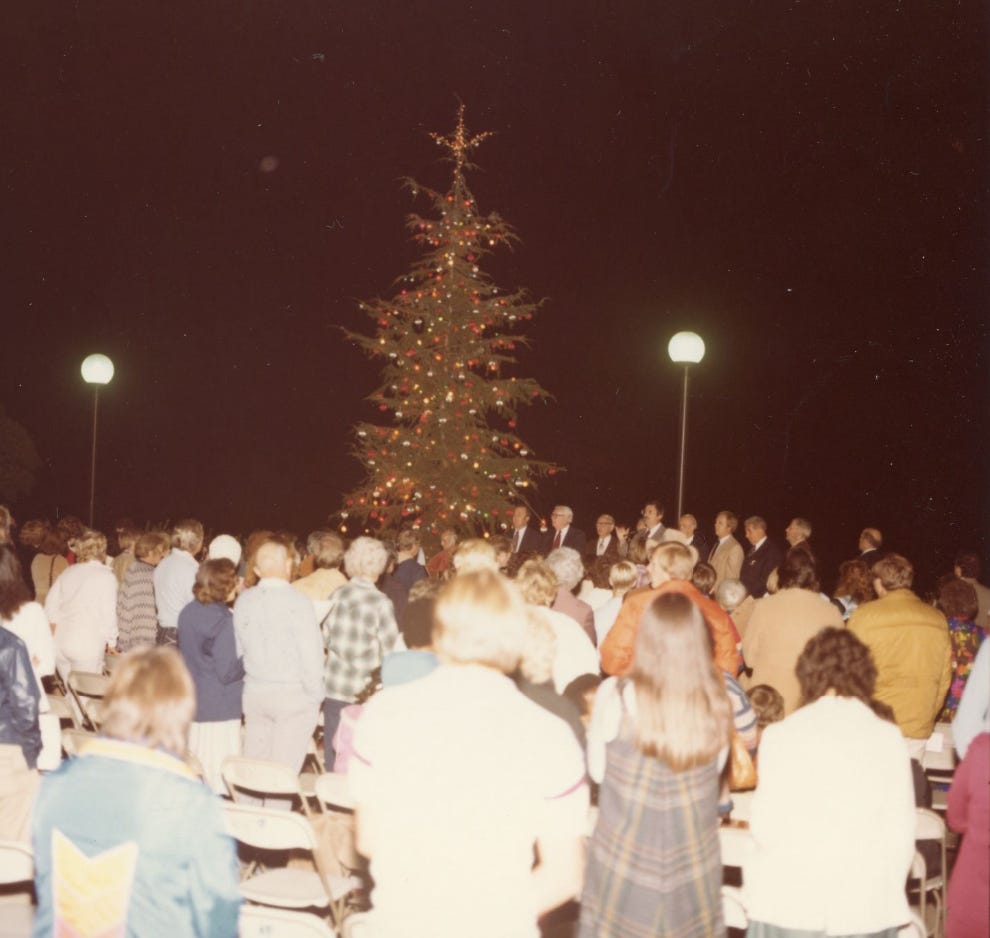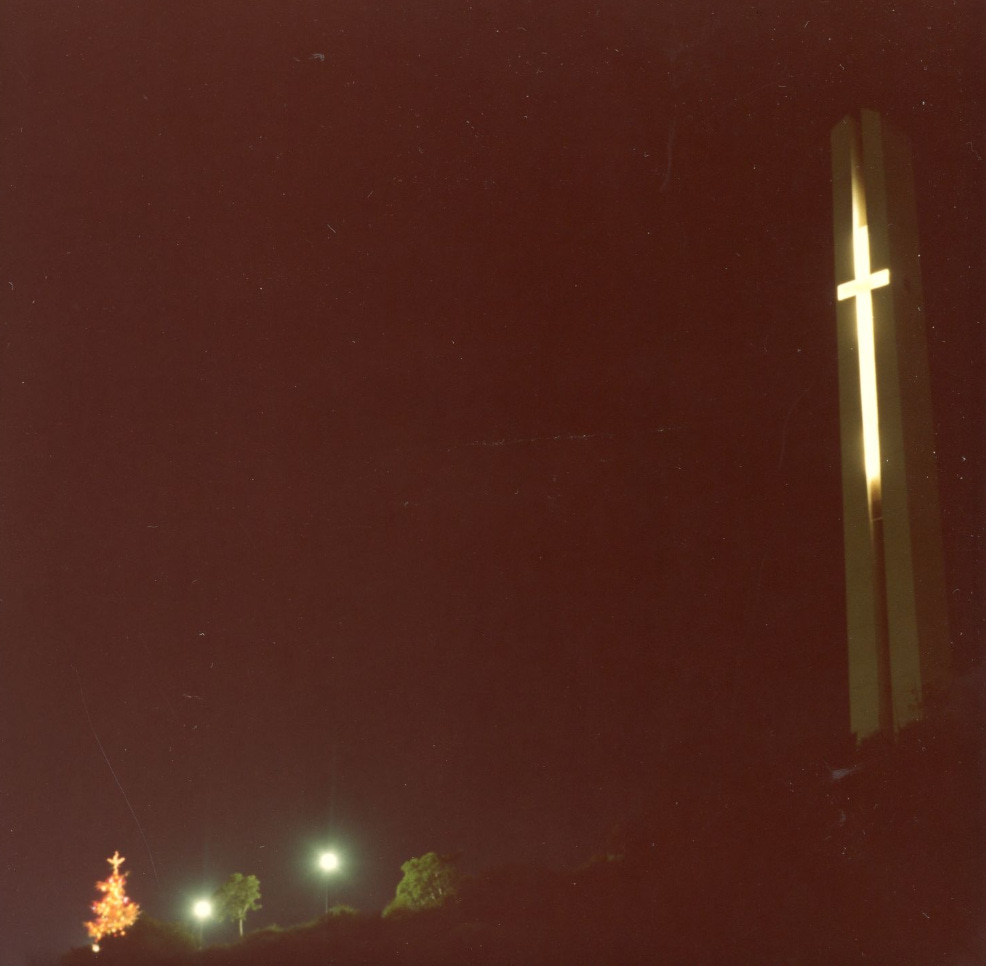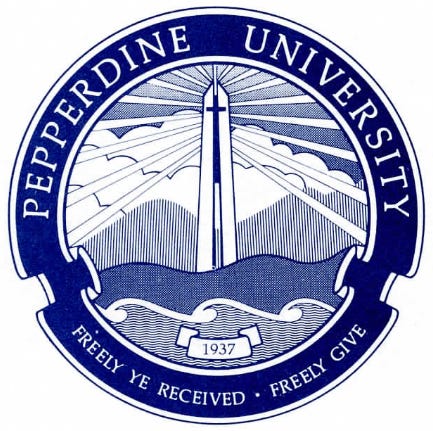Under a bushel
Why Pepperdine's theme tower has remained unlit for over forty years
Advent is a season of gathering light. If you ask me, the most striking advent narrative in the Bible is from the Gospel of John, which dispenses with the shepherds, angels, and magi, preferring a simple image of gathering light: “The true light that gives light to everyone was coming into the world” (John 1:9). In that spirit, I would like to recount a series of stories from Pepperdine’s history on the theme of light.
Merry Christmas. I’ll be back with more Pepperdine history in the new year.
In 1980, Pepperdine invited the Malibu community to campus to celebrate the lighting of a Christmas tree that had been jointly given to the university by the Optimist Club and the Adamson family (the Malibu landowners who had donated the Malibu land to Pepperdine in 1968). The tree was a 25-foot deodar cedar planted near the theme tower parking lot. A plaque nearby commemorated the dedication of the tree, naming it “Christmas in America.”1 The crowd gathered at dusk to sing carols and to hear from president Howard A. White and chancellor M. Norvel Young. The tree lighting ceremony became a tradition that was repeated in subsequent years.

As nice as the tree looked, it wasn’t the most interesting thing lit up on campus that evening. The Phillips Theme Tower, Pepperdine’s iconic cross tower/obelisk, was also illuminated, its embedded cross shining across the Santa Monica Bay.2

Construction of the theme tower began in 1972, and it was wired with lights from the beginning, which neighbors in Malibu did not appreciate. In his memoir, president William S. Banowsky recalls cutting a deal with the disgruntled Malibuites at a meeting in 1972: he agreed to keep the lights off during his presidency, and in return the neighbors would drop their suit and allow the tower’s construction to go forward.3 He insists that the deal only applied to his presidency, asking, “How could I stand up at an informal meeting and establish an eternal policy for Pepperdine?” But Banowsky’s opponents remember it differently, recalling in 2007 that he had “promised not to light the tower—ever.”4
Regardless of how the deal was structured, the tower was in fact lit during Banowsky’s presidency, an inconvenient fact that he omits from his version of the story. The tower’s first lighting (as far as I’ve been able to determine) was during the Christmas season in 1977, several months before the end of Banowsky’s presidency. Permission for the lights came from an LA County supervisor,5 who allowed Pepperdine to light the tower as long as no neighbors complained.6
This arrangement lasted for a few years, but by 1981 there had been some complaints from community members, whom student journalist Rick Cupp called “more tolerant of the light around Christmas time.”7 The lights were evidently turned off around this time, and as far as I know, they have stayed off ever since.8
I don’t think it’s a coincidence that the university’s official seal, which depicts rays of light beaming from the theme tower, debuted around 1979, during the short period when the tower was still being lit.9
Children to the dark tower came
For generations since the lights were turned off, students have periodically tried to persuade the university’s administration to turn them back on.10 In 2002, a student group seeking to get the lights turned on for a 9/11 memorial ended up compromising with administration on a plan that would shine lights at the tower, not from it.11 In 2006, a Facebook group called “Light the Tower” reignited the conversation, even earning some coverage in the Los Angeles Times, but I don’t think anything ever came of it.12 Then-president Andrew Benton said, “Student efforts to light the cross pop up about every three months.”13
The last news on this front that I’m aware of is from 2022, when the tower was lit externally with purple lights as part of a Veterans Day celebration.14

Fiat lux: The case for lighting the tower
I’m in favor of turning the lights back on. It would be inspiring to realize Banowsky’s vision of a beacon symbolizing Pepperdine’s Christian commitment. He told The Graphic in 2007, “I promised not to light it while I was president, but I built it with lights because I hoped that a later administration would light it.”15
I know there are strong reasons to keep it dark. It would be a shame for the cross of Christ to become a bone of contention between town and gown. But Pepperdine also has a duty to let its light shine before men. A city on a hill cannot be hidden, and no one lights a candle and puts it under a bushel.
And it would be worse to reduce Pepperdine’s Christian heritage to just a glowing cross. I agree with president Benton, who said, “I don’t think it takes a neon-lit cross to strengthen our outreach.”16 But it’s also possible to have a sincere Christian commitment and strong community outreach while also broadcasting the university’s religious identity from the hilltop.
And of course there might be costs associated with getting the lights to work after more than forty years of disuse. Not to mention, it would probably be a hassle to get the county’s approval. But I think these are costs worth bearing (and there might even be a donor somewhere who would chip in to defray the costs).
If Pepperdine were going to light the cross, I think Christmastime would be a good time to do it. There’s already a strong social norm of putting up with neighbors’ outdoor lights this time of year, even ones that are religiously motivated.
Like John the Evangelist, former president David Davenport was especially fond of the light metaphor. In his inaugural address, “Lighting the Way,” he spoke eloquently of Christian higher education as a light:
We, along with the 3,000 other colleges and universities in America, are really in the business of light. From the earliest of times, men have spoken of the darkness of ignorance and the light of knowledge, the darkness of the unknown and the light of discovery, the darkness of aimlessness and the light of values. Like the thrilling relay of the Olympic torch last summer, beginning in Athens and ending here in Los Angeles, one can almost trace the history and outline the task of the university beginning with the light of Plato’s academy in Athens, carrying the torch across to Jerusalem and Rome, through the medieval universities of Europe, across the ocean to Harvard in 1636, and then lighting the way across this nation to Malibu in the twentieth century. The picture of universities lighting the way, both chronologically across the years and geographically across the miles, brings to mind the observation of H. G. Wells that “human history becomes more and more a race between education and catastrophe.” If mankind is to win this perilous contest, our universities must boldly light the way, with the glowing light of reflection, the searching light of discovery, and the guiding light of values.17
So I say, let there be light.
The plaque, which can be seen here, is still in place near the theme tower lot, but the tree is now gone, leaving behind just a stump. I’m not sure when it was removed.
Kaitlin Flynn, “Tower remains dark; debate persists,” The Graphic, 8 Nov. 2007: A3.
William S. Banowsky, The Malibu Miracle: A Memoir, Pepp. Univ. Press (2010): 288–89. By the year 2000 or so, a persistent rumor on campus attributed the dark tower to complaints lodged by Malibuite entertainer Barbra Streisand. For decades, every source addressing the rumor has done so to debunk it. I know of no evidence that Streisand was involved. Banowsky seems mostly to have negotiated with Alvin Kaufer and Marca Helfrich, who represented a Malibu homeowners association. See, e.g., Cassy Lamensky, “Pep urban legends prove mere rumors,“ The Graphic, 15 Mar. 2001: A3; cf. JJ Bowman, “Truth spoils great Babs rumor,” The Graphic, 22 Mar. 2001: A7. See also, Banowsky, supra: 281; and Flynn, supra note 2.
Flynn, supra note 2.
The Graphic reported that the supervisor in question was James Hayes, but David Baird says it was Pepperdine alumnus Kenneth Hahn. See “Approval granted for tower lights,” The Graphic, 19 Jan. 1978: 1; cf. W. David Baird, Quest for Distinction: Pepperdine University in the 20th Century, Pepp. Univ. Press (2016): 297. I can’t rule out Hahn’s involvement, but the primary sources I have seen (including some cited by Baird himself) all point to supervisor Hayes and his press deputy Paul Flowers. See Bob Thomas to Mike O’Neal, 6 Sept. 1978, Box 9, Folder 4 (“1978–1979”), Baird papers, Pepp. Univ. Special Collections and University Archives (SCUA); cf. O’Neal to Thomas, 27 Sept. 1978, ibid. Some of the archival sources cited by Baird are not accessible at this time.
James Taylor, “Pep fights for Tower light,” The Graphic, 6 Feb. 1986: A4.
I’m uncertain whether the tower lights remained on year-round or only during the holiday season, but sources lead me to believe it was year-round, beginning around Christmas 1977. See “Approval granted,” supra note 5; Taylor, supra note 6; and memos from Thomas and O’Neal, supra note 5. On the other hand, Cupp makes me think that by 1980 they may have been turned on only during the holiday season. See Rick Cupp, “Resolution to allocate lighting funds passes,” The Graphic, 30 Nov. 1981: 1.
See Baird, supra note 5: 297.
I’m rather dense, so in my previous coverage of the seal I referred to the rays of light as “sunbeams.” In the context of lighting the tower, though, it’s clear that they are coming from the tower itself! It may be significant that the beams are missing from the simplified shield icon now in use. See Banowsky, supra note 3: 280.
See, e.g., Laurie Babinski, “‘And God said, ‘Let there be light’?,” The Graphic, 15 Mar. 2001: A3–A4. See also Taylor, supra note 6.
Peter Celauro, “There shall be light,” The Graphic, 19 Sept. 2002: A9; cf. “We will never forget: One year later Pepperdine students remember Sept. 11, 2001,” Impressions 2003: 109. See also Flynn, supra note 2. Note, too, that the tower may have been lit again on Sept. 11, 2003; see Impressions 2004: 3.
Lynn Doan, “Support for Lighted Cross Rekindles Old Debate,” Los Angeles Times, 1 July 2006.
Quoted in Banowsky, supra note 3: 280, and Doan, supra note 13.
“Pepperdine University to Commemorate Veterans Day by Illuminating Phillips Theme Tower,” Pepperdine Newsroom, 9 Nov. 2022; cf. Abby Wilt, “Light to Unite: Pepperdine Lights Up Phillips Theme Tower,” The Graphic, 11 Nov. 2022.
Flynn, supra note 2.
Quoted in Banowsky, supra note 3: 289, and Doan, supra note 13.
David Davenport, “Lighting the Way,” 21 Oct. 1985, Box 1, "Davenport" file, Pepperdine University Speeches collection, SCUA.


